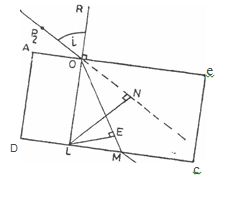|
|
Alternative b
Question 5
|
(a) Diagram

You are provided with a rectangular glass prism, drawing board, drawing papers, four optical pins
and other necessary apparatus.
-
Using the diagram above as a guide, carry out the following instructions.
(i) Trace the outline ABCD of the glass block on a sheet of paper attached to the drawing
board.
(ii)Remove the block and mark a position 0 such that AO is about one quarter of AB.
(iii) Draw the normal ROL and the incident ray such that I = 20°.
(iv)Fix two pins at points PI and P2 on the incident ray.
(v) Replace the block and fix two other pins at points P3 and P4 such that the pins appear to
be in a straight line with the images ofthe pins appear to be in a straight line with the
images of the pins at PI and P2 when viewed through the block from the side DC of the
block.
(vi) Remove the block and join the points P 4 and P3 producing the line to meet DC at M.
(vii) Draw' a line to join points 0 and M.
(viii) Draw the normals LE and LN to the refracted ray and the extended incident ray
respectivel y .
(ix) Measure and record the lengths LE and LN.
(x)Repeat the procedure for other values of! == 3°, 40°,50° and 60°.
(xi)Tabulate your readings.
(xii) Plot a graph with LE on the vertical axis and LN on the horizontal axis.
(xiii) Determine the slope, s, of the graph.
(xiv) Evaluate K = 1 /s
(xv) State two precautions taken to obtain accurate results.
(Attach your traces to your answer booklet.)
(b)(i) What is meant by the statement: the refractive index of glass is 1.5?
(ii) The bottom of a pool 4m deep, appears to be displaced by 1m when viewed from above.
Calculated the refractive index of water in the pool.
|
| _____________________________________________________________________________________________________ |
|
Well attempted by most candidates. However, some candidates failed to actually perform the
experiment as evident in the traces they submitted which bears no pin holes. Some responding
candidates could not draw LE and LM accurately.
Evaluation of Cos (θ)/2 was a challenge to some of the candidates. Rather they were
evaluating Cos θ/2.
The part (b )(i) and (ii) was poorly answered.
The expected answers are:
(a) OBSERVATIONS [09]
(i) Five complete traces showing at least, incident, refracted
and emergent rays: LE, LN.
(ii)Five values of i recorded in degrees
(iii)Five values of LE measured and recorded in cm to at
least 1 decimal place, and in trend.
(Trend: As I increases LE increase).
(iv) Five values ofLN measured and recorded in em to at
least 1 decimal place and in trend.
(v) Composite table showing at least i, LE and LN
NOTE: I. Award zero for (i), (ii), (iii) and (iv) if traces is not attached or
II. If no pin marks are observed on attached traces award zero for (i) - (iv).
GRAPH (06)
(i) Both axes correctly distinguished,
(ii) Reasonable scales, Y:z mark each.
(iii)Five points correctly plotted
(iv) Line of best fit
SLOPE [02]
(i) Large right angled triangle
(ii)∆LE correctly determined
(iii)∆LN correctly determined
(iv)∆LE correctly evaluated
∆LN
EVALUATION [011
Correctly substituted for k = l/s
correct arithmetic
ACCURACY [OlJ
Based on teachers refractive index of glass = 1.5 + 5%.
K = refractive index
PRECAUTIONS [02]
Award 1 mark each for any two correct precautions
e.g.
- Pins are located vertically
- Pins are adequately spaced (at least 4 em).
- Avoided parallax error while reading the protractor/ruler
- Repeated readings (shown on table and traces)
- Neat traces
Zero error noted and corrected for on metre rule
(Accept any other valid precautions)
(b) (i) Refractive index means that the speed of light is 1.5 times greater in air than in the glass
(Accept any other valid explanation)
(ii) Real depth = 4m
Apparent depth = 4 - I = 3m
n = Real depth
Apparent depth
= 4/3
= 1.33
|
|
|
|



